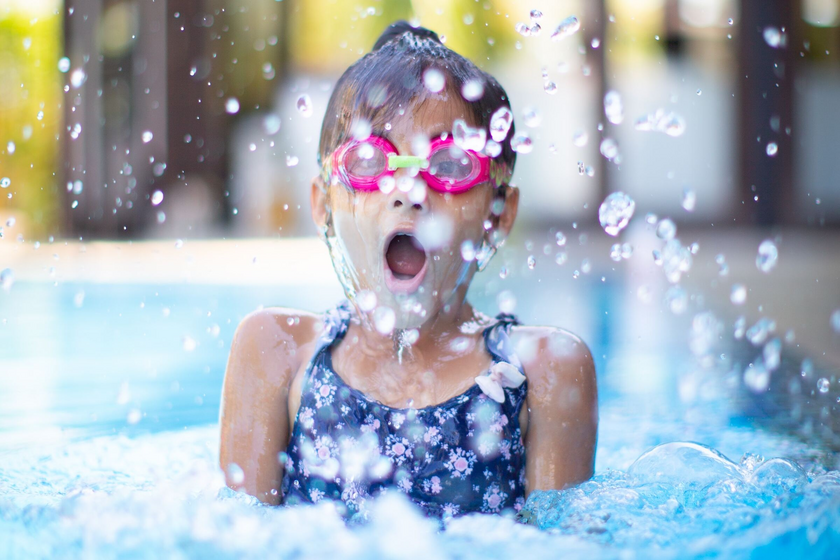
Why is water safety such an important topic? It’s because drowning is the single-leading cause of death among children ages 1 to 4, and a top cause of death among teens. And for every child that dies, many more go to the ER and suffer physical and neurological damage after a near-drowning experience. In Florida there are so many bodies of water—including swimming pools, retention ponds, lakes and beaches—it is a good idea to familiarize yourself with the basics of drowning prevention. You might be surprised at some of the myths about water safety and the precautions recommended by experts. Please take a few minutes to learn more—you could save a young life!
4 Surprising Water Safety Myths
Myth #1 – “It would never happen to us.”
If you think you can watch your kids 24/7, please immediately discard that notion. Every parent who has lost a child to drowning says that they believed it would never happen to them. Most drownings happen during non-swim time. In other words, a child will wander into the pool when parents are least expecting their child to be in the pool.
The only difference between the funny picture you see on social media of a mischievous child who got into mommy’s makeup and a post about a funeral service is water. In the time it takes for a parent to discover her child has drawn all over herself with makeup (or found a way to slip outside), it’s too late. Twenty seconds is all it takes for a child to drown.
Myth #2 – You Can Depend on Pool Safety Alarms or Other Products
Pool safety products are best used as part of a layered system of protection. Locks on doors and windows and a pool fence are necessary, but parents need to know that they all can fail. Alarms can be disarmed, and even if momentarily, that’s all it takes. Doors and fences can be left unlocked or, worse yet, left open. Kids have even been known to climb over them. It’s very easy to push a plastic kid’s table up against the pool fence and climb right over.
Myth #3 – Flotation Devices Are Adequate Water Safety Products
Puddle jumpers and floaties can create a false sense of security in the water. Children become accustomed to being safe in a vertical position in the water. They feel like they can “swim” when that’s not the case. Which means when they find themselves in the water without a flotation device, they immediately assume they’ll be safe in a vertical position, which is sadly the drowning position.
This false sense of security applies to parents and grandparents, too. They feel that they can look at their phone or read a book because the kids are wearing flotation devices. Kids jump in and out of the pool, take them off at lunchtime or while doing other activities near the pool, and can easily forget they’re not wearing their floaties. Paying less attention while leaning on pool safety products is when the unthinkable happens. Of course, kids should always wear coast guard-approved life jackets while boating on open water or walking on a dock, but not in a pool.
Myth #4 – The Water is a Fun and Safe Place
In our society, we tend to communicate to kids that the water is ALWAYS a fun and safe place. The bathtub is fun because they’ve got mom’s undivided attention, they can splash, it’s warm and they have toys. In the pool, they have flotation devices and toys, and parents are likely to say, “Let’s go swimming,” even if it’s just splashing on the steps. Kids don’t think things through. They are impulsive and will try to have the same fun without supervision. Swim schools teach respect for the water, survival skills and how to have fun in the water. Instructors also show parents the skills their kids have been practicing and how to reinforce them at home.
The #1 Water Safety Tip for Kids is Swimming Lessons
No matter what other layers of protection you use (because we hope by now you realize that they all can fail), there is NOTHING more important than a child knowing how to handle himself in the water. The most important thing a parent can do is ensure that their child has the skills necessary to independently swim and float in the water in case every other safeguard fails.
When is the Right Time to Begin Swimming Lessons?
The American Academy of Pediatrics suggests that at a year, children can start formal swim lessons. It’s their official position to speak with your pediatrician at a year old to assess a child’s drowning risk and whether swim lessons would be appropriate for your family.
That said, swim instructors can start children with lessons as soon as they have the core strength to get into a sitting position on their own. At that time, developmentally, they can hold a floating posture in the water. They can be taught how to hold their breath and move through the water face down, roll onto their backs to breathe, and hold a float until somebody rescues them. This could be anywhere from six to eight months old.
Also consider the risk that a child is exposed to. Swimming lessons should be prioritized if a child lives in a home with a pool or spends time at a home with a pool. Other circumstances also have an impact. For example, if you have older kids and a crawling child, it’s likely that he will follow the older kids around, which increases his chance of falling in the pool.
How Long Do Kids Need to Take Swimming Lessons?
Most programs offer 10-minute lessons, four or five times per week for between four and six weeks. Learning to swim is a process that spans years. A good swim program will help children reach their potential at each round of lessons, but it is essential to return and refresh the skills as they grow. This is especially true after the winter break when most kids have not been in the pool consistently.
How Do I Choose the Best Instructor for My Child?
Watch some instructors teach. Talk to the parents at the side of the pool. Don’t discount a program or instructor because a child is crying. Just because a child might not like her lesson doesn’t mean she’s not learning lifesaving skills. Initially, children will likely feel like they have no control, but as their skills develop and with the right instructor interaction, they will feel more at ease. Don’t focus on the emotion, focus on your desired result. Do you want a child who knows what to do if she falls in the pool? Some tears are worth saving a life.
Make sure you are getting survival-type lessons. Just splashing around to get kids used to the water doesn’t show kids what could happen if mom wasn’t in the pool. This can actually draw kids to water because they go looking for the fun they had the last time they were in the water. Again, the water is not a safe place for kids who have not been taught water survival skills. It’s an instructor’s job to give children the skills that help them to feel in control in the water. It’s a very personal choice. Look for the instructor who you feel would get along best with your child.
Special Considerations for Special Needs Kids
Kids on the spectrum are absolutely drawn to water and should get swimming lessons as soon as they can. Good instructors already treat each child as an individual. They adjust their teaching style to help kids gain water survival skills. The usual skills taught are swimming with their face in the water, rolling on their backs when they need a breath, floating on their back, and then continuing to swim. Kids can be taught even if sensory issues make it difficult for them, for example, to put their face in the water. Sometimes expectations need to be modified for children on the spectrum, but they will still learn how to be safe.
Layer Water Safety Products and Habits
After providing swimming lessons, building layers of protection between your kids and the water is the next best strategy to keep your kids safe from drowning. The best layers are those that fit in with your lifestyle.
Isolate Your Pool
Many Florida homes have a screened pool area, which protects it from the neighbors, but since back doors lead out to the pool, you need to have a fence between the doors and the windows of the house and the pool. In the warmer months we tend to keep the back doors closed to preserve air conditioning, but in the cooler months, we may open the back door or some windows as we use the outside patio. No matter what time of year, a fence around the pool ensures that kids can’t access the pool if they manage to sneak out back. Self-closing gates close and latch automatically so that when you’re using the pool, it’s less likely a child will slip in behind anyone.
What About a Pool Cover? Is That Not Good Enough?
A pool cover can effectively isolate the pool during the winter months, but most folks do not put the cover back on after using it during the summer. It only takes being lazy once for the unthinkable to happen. The risk is too great. A pool fence is best!
Alarms and Other Water Safety Products
Regular home security door and window alarms can provide additional layers of protection. There are also pool entry alarms that go off when surface waves are detected. Depending on sensitivity and settings, these devices can generate false alarms to the extent that they are ignored or switched off—making them completely ineffective. There are also products that strap to the wrist of a child (like a watch) that will sound an alert from a base station if it touches water. These are generally good for a temporary, short-term situation, like visiting a friend or relative’s home. Again, it’s important to layer with products and techniques that best fit your lifestyle.
Set Pool Rules for Kids and Adults
As kids get older, set pool safety rules. Sit down with the kids and talk about what they can do to keep themselves safe. There are three main rules that they need to know. 1) Don’t go near the pool without asking Mommy and Daddy. 2) Mommy and Daddy must be watching you when you’re in the pool. 3) No running!
For adults, the most important pool safety rule is to assign a “water watcher” whenever there is a child near the pool. It is the water watcher’s only job to watch the children for ten or fifteen minutes. During that time, they agree they will do nothing else—NO distractions! No mobile phone or conversations with others. Create a lanyard or wrist bracelet that the water watchers wear to remind them (and everyone else) that they should not be distracted for any reason while they are on duty. Breaking up the supervision is much more effective than one person trying to be on the lookout for the entire party. Events can take a bad turn quickly when multiple kids are involved, especially if one must go inside and be attended to. This rule also eliminates catastrophes that happen when all the adults assume “everybody else” is watching.
Learn CPR and Have a Water Safety Emergency Plan
In recent years, people have been reluctant to engage in CPR because they don’t like the mouth-to-mouth aspect. If you come across a somebody who’s had a heart attack, for example, the American Heart Association instructs people to give compression-only CPR. In the case of a drowning victim, that advice doesn’t apply, because a drowning victim’s blood supply has been depleted of oxygen and just providing compressions to pump blood around the body isn’t helpful. You also need to give those breaths to replenish some of the oxygen in the blood.
To prepare for an emergency, make sure you have a phone near the pool to dial 911 and that everyone knows the information a dispatcher will need (like the home’s address) to get EMS there quickly. For days at the beach, take a picture of your child as soon as you arrive so that you can just show that to other people and lifeguards instead of trying to describe your child under duress. Choose bathing suits with bright neon colors which are much easier to see in natural bodies of water.
Inspect Your Pool Defenses Regularly
As children grow, they become better escape artists! What was effective for a one-year-old will not be as effective on a six-year-old. Door latches and pool fences need to be reevaluated continuously. And don’t forget the doggie door!
Drowning is preventable! We hope you found these tips useful. Have a safe and happy swimming season!
Much thanks to Geoff Dawson from The Pool Safety Resource and Kelly Wiggins from Swim Life for their expertise and help in writing this article.
Photo by Raj Rana on Unsplash





